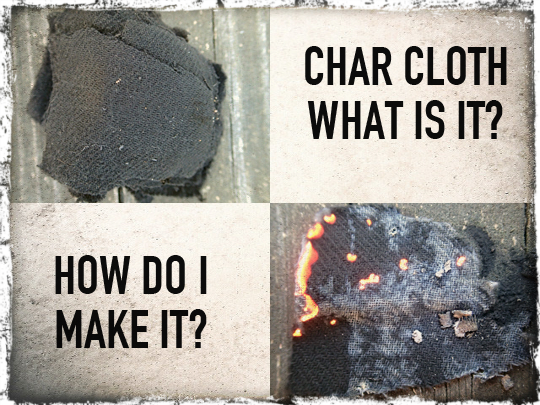
Most people know it as char cloth but it is also called “charpaper”. Char cloth is made using vegetable fiber and the most common fiber used is cotton but it can also be made from linen and jute.
The process to covert the cloth to carbon form is called “pyrolysis”, which is nothing more than the decomposition of molecules by heat to break a chemical substance down into a simpler form. The making of char cloth causes a chemical reaction as it forces most of the gases out of the material, but not all of them, otherwise you would end up with a pile of black ash.
Synthetic materials would not reduce to carbon form when heated, synthetic material is not organic and would essentially melt away. Burning of this type material may also produce toxic fumes.
The process reduces the material to its carbon form, however if heated too long it will reduce to ash form. It may take a bit of practice to get the cloth to where it can be handled without crumbling apart and yet has achieved the low ignition point.
One hundred percent cotton tee shirts are ideal for making char cloth and some have had luck using cotton balls as long as they say 100 percent cotton.
The cloth once converted correctly is slow burning with a low ignition temperature. The material can be ignited with a single spark, which in turn is used to ignite dry tinder. Once you have char cloth all you need to create an ember is a spark.
Always make your char cloth outside where having a fire is not a safety hazard. The process will create fumes/gases.
Making Char Cloth
Materials Needed
1.) Small metal container than can be sealed tightly such as a mint tin, (altoids) or other container.
2.) Cotton, linen or jute fabric
3.) Tool (s) to cut the material to fit into the container
4.) Fire source, open flame is recommended
5). Heavy gloves to handle the hot container or metal pliers/tongs large enough to grasp the container
6.) Tool (s) to create a small hole in the container lid, use a small nail, or drill a hole
The hole is essential. It is needed to allow the gases to escape and yet is not so large as to allow oxygen to reach the material. Use a finishing nail end and just puncture the metal with the tip of the nail.
Cut the cloth to fit into the can and you can roll or layer the material. Seal and place close to the flame, you just want heat applied to the bottom or one side, in other words do not allow the flame to lick up the sides or over the top of the container. You want slow partial combustion.
Once on the flame you will see, smoke/gas escaping from the hole after a few minutes. The gas is flammable. Once the smoke stops flowing out the hole or is reduced dramatically, you can flip the can over to make sure the entire material has been charred, and then look for more smoke. Remove if you do not see any.
Leaving the container on the heat after the gases have stopped flowing out the hole will allow oxygen to enter which will accelerate combustion, and this of course will burn up the material. The gases exiting the hole prevent oxygen from entering.
Let cool and then remove the cloth. Check your work by creating a spark to see if the char cloth will take the spark and form an ember. Once lit char cloth can be difficult to extinguish. You may have to seal it in a metal container to deprive it of oxygen; otherwise, it will burn up the entire piece and can be a fire hazard if left unattended.